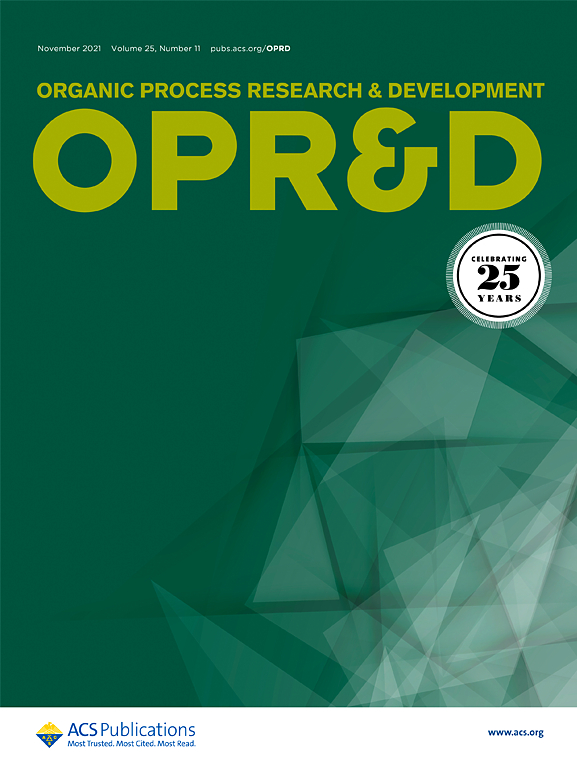Efficient Production of Inhalable Micro-Nanoparticles: Mechanism, Process Optimization, and Modular Continuous Micro-Crystallizer Design
IF 3.1
3区 化学
Q2 CHEMISTRY, APPLIED
引用次数: 0
Abstract
Batch production of micro-nanoparticles suffers from high energy consumption and low efficiency, and continuous crystallization is considered a promising solution. This study reported the design of a modular continuous coaxial mixing crystallizer (CCMC) system for the production of micro-nanoparticles of the pharmaceutical compound fluticasone propionate (FP), and the performance of the system was evaluated. Guided by experimentally determined thermodynamic and kinetic data of FP crystallization, computational fluid dynamics simulations were employed to optimize the crystallizer design, resulting in enhanced mixing efficiency occurring within 40 ms. Through a three-stage experimental protocol, the continuous crystallization process was optimized: (1) key process parameters were screened using factorial design; (2) the operational design space was mapped via response surface methodology; and (3) particle size control mechanisms were elucidated through analysis of mixing processes. Quantitative analysis identified the antisolvent-to-solution ratio as the dominant factor governing particle size distribution, attributed to its critical role in nucleation kinetics. The CCMC platform demonstrated robust and efficient operation for 25 min, delivering a single-run output equivalent to 990 doses of commercial formulation. Comparative studies revealed advantages over batch processing, including comparable powder crystallinity, improved crystal morphology, and narrower size distributions within a micro-nanometer range. The coaxial mixing crystallizer system exhibits excellence in flexibility, productivity, and material recovery.

可吸入微纳米颗粒的高效生产:机理、工艺优化和模块化连续微结晶器设计
批量生产微纳米颗粒存在高能耗和低效率的问题,连续结晶被认为是一种很有前途的解决方案。本研究报道了模块化连续同轴混合结晶器(CCMC)系统的设计,用于生产药物化合物丙酸氟替卡松(FP)的微纳米颗粒,并对该系统的性能进行了评估。在实验确定的FP结晶热力学和动力学数据的指导下,利用计算流体动力学模拟优化结晶器设计,使结晶器在40 ms内实现了更高的混合效率。通过三阶段实验方案,对连续结晶工艺进行优化:(1)采用析因设计筛选关键工艺参数;(2)通过响应面方法映射操作设计空间;(3)通过对混合过程的分析,阐明了粒径控制机理。定量分析发现,抗溶剂与溶液的比例是决定粒径分布的主要因素,因为它在成核动力学中起着关键作用。CCMC平台在25分钟内展示了稳健和高效的操作,单趟输出相当于990剂商业配方。对比研究揭示了批量加工的优势,包括可比较的粉末结晶度,改进的晶体形态,以及在微纳米范围内更窄的尺寸分布。同轴混合结晶器系统表现出卓越的灵活性,生产力和材料回收。
本文章由计算机程序翻译,如有差异,请以英文原文为准。
求助全文
约1分钟内获得全文
求助全文
来源期刊
CiteScore
6.90
自引率
14.70%
发文量
251
审稿时长
2 months
期刊介绍:
The journal Organic Process Research & Development serves as a communication tool between industrial chemists and chemists working in universities and research institutes. As such, it reports original work from the broad field of industrial process chemistry but also presents academic results that are relevant, or potentially relevant, to industrial applications. Process chemistry is the science that enables the safe, environmentally benign and ultimately economical manufacturing of organic compounds that are required in larger amounts to help address the needs of society. Consequently, the Journal encompasses every aspect of organic chemistry, including all aspects of catalysis, synthetic methodology development and synthetic strategy exploration, but also includes aspects from analytical and solid-state chemistry and chemical engineering, such as work-up tools,process safety, or flow-chemistry. The goal of development and optimization of chemical reactions and processes is their transfer to a larger scale; original work describing such studies and the actual implementation on scale is highly relevant to the journal. However, studies on new developments from either industry, research institutes or academia that have not yet been demonstrated on scale, but where an industrial utility can be expected and where the study has addressed important prerequisites for a scale-up and has given confidence into the reliability and practicality of the chemistry, also serve the mission of OPR&D as a communication tool between the different contributors to the field.

 求助内容:
求助内容: 应助结果提醒方式:
应助结果提醒方式:


